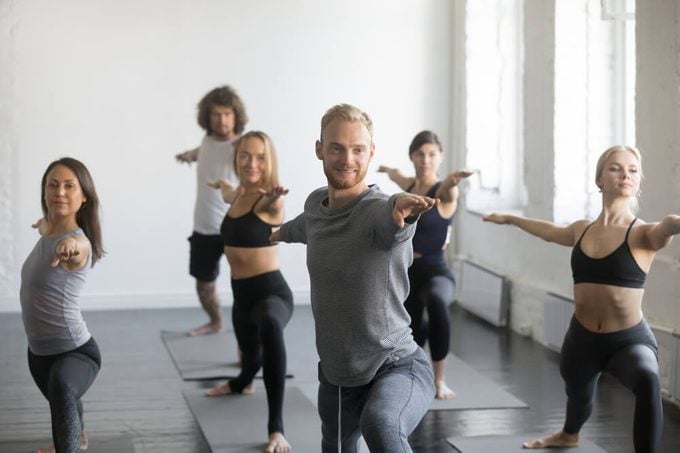These 10 Secrets of Scandinavians Are Why They’re So Healthy
Updated: Jan. 24, 2023
When you think Scandinavia, do you conjure up images of vigorous rosy-cheeked people, filled with energy and optimism? Who doesn't? That vision is more than just the stuff of Nordic mythology, it's based on facts and the healthy lifestyle habits typical throughout the Land of the Midnight Sun.
 The how and why of Scandinavian food
The how and why of Scandinavian food
The Scandi diet is big on reducing starchy carbs and replacing those calories with heaping servings of healthy proteins, such as locally-sourced, cold-water fish, and organic vegetables. Just as importantly, Scandinavians believe it’s not just what you eat that counts, it’s how you prepare it that matters too. “Cooking is a major part of the Scandinavian culture and something kids are taught to do from an early age. Combined with almost-universal access to fresh produce and fish, Scandinavians generally eat healthier than most Americans,” says Christel Oerum, a diabetes advocate and Danish-expat living in Los Angeles.
Scandinavians also believe that junk food is, well, junk. “Out of all the countries, the U.S. and U.K. take the top spots for consuming the most junk food, including pizza, and deep-fried foods. Swedes consume the least, an easy-to-nab habit, which contributes greatly to their health,” adds Frida Harju Westman, in-house nutritionist for Scandinavian health app, Lifesum. Find out the surprising foods that Swedes, and healthy people from countries around the world, eat for breakfast.
Sauna-obsessed
The next time you pass up the sauna in your gym, you just might want to rethink your quick post-workout getaway. Scandinavians are more than obsessed with saunas—in fact, there are over 2.2 million in Finland alone! This feel-good obsession is steeped in science as well as sweat—a study done by scientists at the University of Eastern Finland found that a 30-minute sauna reduced blood pressure and increased heart rates to levels comparable with moderate exercise. Saunas also help you sweat out toxins and alleviate stress.
If you think too much is not enough, you’re probably not Scandinavian
Scandinavian people take a moderate approach to all things in life—from food to work. This way of living is called lagom, and is a large part of Nordic philosophy. It may also be a reason why Scandinavian countries are as healthy as they are, says Westman. “Lagom is an idea of ‘just the right amount,’ meaning, you don’t restrict anything, but also don’t have anything in excess. Lagom applies to all areas of life,” she explains.
Living the free-air life
 Westman explains it as a heartfelt belief that nature is our true home. Vogue calls it the perfect summer antidote to the Scandi passion for coziness during cold-weather months. Both are talking about friluftsliv—a powerful part of the Scandinavian philosophy for living a natural, healthy life. This unpronounceable word with Norwegian roots translates loosely into “free-air life.” It represents a philosophy that focuses on human being’s place in the natural world, where we are meant to be, and gets Scandinavian people outdoors and into nature every single day. “Friluftsliv leads us to spending as much time as possible outside, breathing the fresh air, and getting fit in the process,” says Westman.
Westman explains it as a heartfelt belief that nature is our true home. Vogue calls it the perfect summer antidote to the Scandi passion for coziness during cold-weather months. Both are talking about friluftsliv—a powerful part of the Scandinavian philosophy for living a natural, healthy life. This unpronounceable word with Norwegian roots translates loosely into “free-air life.” It represents a philosophy that focuses on human being’s place in the natural world, where we are meant to be, and gets Scandinavian people outdoors and into nature every single day. “Friluftsliv leads us to spending as much time as possible outside, breathing the fresh air, and getting fit in the process,” says Westman.
On your feet, or on your (bicycle) wheels
Single digit temperatures (or lower) are the norm in much of Scandinavia during winter. Even so, almost all Scandinavian cities are designed for easy biking and walking. “In Copenhagen, 50 percent of the locals commute to work by bike daily and another 25 percent walk or use a combination of public transportation and walking,” says Oerum. And it doesn’t matter what the weather is like, according to Denmark’s official website. Even in the snow, sleet, or freezing cold, you’ll see more people biking to their destinations than you will see taking public transportation. Find out the most bike-friendly cities in every single U.S. state.
The government (and employers) support guilt-free parenting that doesn’t bankrupt you
The parental-leave career juggle is a stressful one for most American parents. The anxiety of leaving a baby too soon, plus the stress of a job, can create health-busting emotional turmoil. Can you imagine living in a country where the government puts families first, mandating up to 16 months of paid family leave after a baby’s birth, or adoption? That’s what many Scandinavian countries make available to every citizen who wants it. Miami native Aparna Majmudar, who has lived and worked in Denmark with her Danish husband and three small children for eight years, shares, “I credit so much of Scandinavians good health and social vibrancy to the way the state-run health system approaches pregnancy, birth, and the formative first years. I also think the Danish work culture and its flexible frames contribute greatly to keeping families, and society, whole,” she says.
Drinking less, enjoying life more
Bitter-cold temperatures, and long, dark days with little-to-no sunlight, can create a perfect storm for binge drinking, depression, and alcoholism. However, Scandinavia’s healthiest folks apply the lagom philosophy to alcohol intake. According to Westman, lifesum’s proprietary data indicates that Norwegians drink the least amount of alcohol than people in many other countries, including the U.S., and U.K., and WEST reports that rates of alcohol use by young adults and teenagers in Sweden and Finland are lower than they have been in decades. These youthful smarties focus on socializing sans booze and the pursuit of physical fitness instead.
Drinking less is good for physical as well as mental health. “Alcohol can be very calorific as they often contain a lot of sugar, which is counterproductive to being healthy. Additionally, drinking alcohol reduces liver function by creating fat around that organ, as well as increasing blood glucose levels,” says Westman. Here’s how the countries with the shortest days beat seasonal depression. And it may have something to do with the Norwegian concept of koselig.
The social scene is built around exercise
 Go to any health club in America, and you’ll mostly see solitary people working out on their own. This is a stark contrast to the way Scandinavians approach socialization and exercise. Sports clubs geared around specific interests and activities abound throughout Scandinavia. This helps bring like-minded people together. Oerum shares that people moving to a new town are advised to join a sports club so that they can more easily make new friends in the local community. “One in three people in Denmark belong to a private sports club, such as soccer, tennis, etc. Sports clubs are a large part of social life in all of Scandinavia. People typically meet one-to-three times per week to play, train together, and socialize,” she adds. Find out the scientific reason exercising in groups is good for you.
Go to any health club in America, and you’ll mostly see solitary people working out on their own. This is a stark contrast to the way Scandinavians approach socialization and exercise. Sports clubs geared around specific interests and activities abound throughout Scandinavia. This helps bring like-minded people together. Oerum shares that people moving to a new town are advised to join a sports club so that they can more easily make new friends in the local community. “One in three people in Denmark belong to a private sports club, such as soccer, tennis, etc. Sports clubs are a large part of social life in all of Scandinavia. People typically meet one-to-three times per week to play, train together, and socialize,” she adds. Find out the scientific reason exercising in groups is good for you.
Exercise is folded into the workplace, too
In Scandinavia, you don’t have to work for a cool startup to get an in-house gym and other health-boosting benefits. “Almost every company in Scandinavia has a health policy, and many invest in healthy food and exercise for their employees. It’s very common for companies to have their own social sports groups, such as biking, running, and soccer. Others pay for employees’ gym memberships,” says Oerum. Many businesses even have an on-site sauna for employees to enjoy. All of this helps to boost morale, increasing feelings of self-worth, and dedication, as well as health.
They’ve taken coffee-culture to a whole new level
Whether at work, home, or play, Scandinavians understand the power of shifting gears to cleanse the mind, enjoy conversation, and restore focus. They often do this with family, friends, or co-workers over a cup of coffee. This ritual is called fika, and it is popular with all age groups, including children, who might opt for hot chocolate instead of a cup of joe. Fika is more about connecting with others than it is about getting a caffeine jolt.
